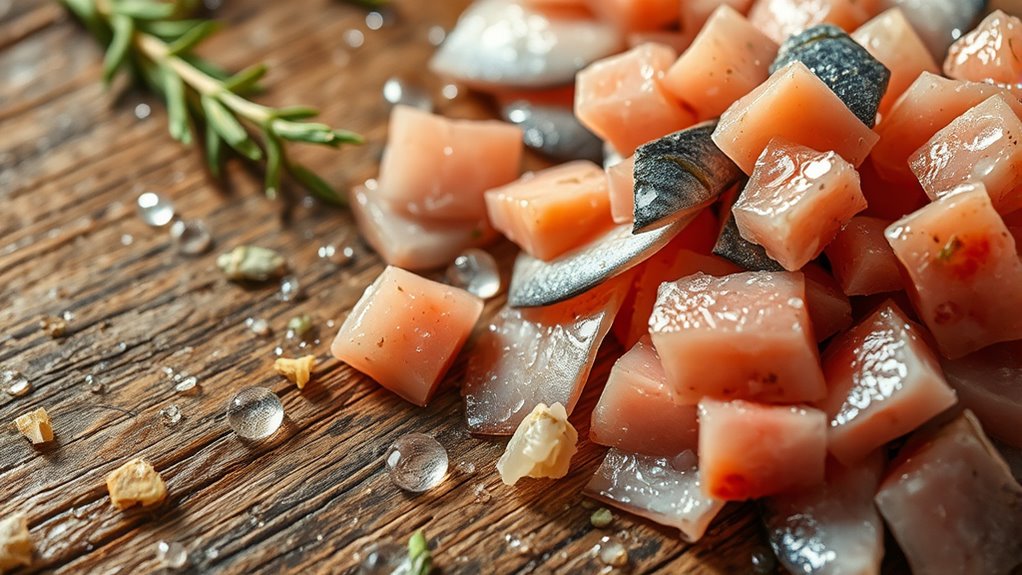In a crisis, you can safely feed your cat foraged fish by carefully selecting clean, uncontaminated sources and properly handling the fish. Rinse thoroughly, then cook it by steaming or boiling to eliminate parasites and bacteria. Avoid adding spices or oils, and remove all bones before offering small, manageable bits. Freezing the fish for 48 hours beforehand adds extra safety. To discover more about preserving and preparing wild fish for your feline, keep exploring these essential tips.
Key Takeaways
- Ensure foraged fish is from clean, uncontaminated waters and properly identified to avoid toxins or choking hazards.
- Rinse thoroughly and cook fish using gentle methods like steaming or boiling to preserve nutrients.
- Remove all bones and chop fish into small, manageable pieces suitable for cats.
- Freeze fish for at least 48 hours before feeding to eliminate parasites and ensure safety.
- Serve small, balanced portions alongside regular feline diets, avoiding overfeeding to prevent nutritional imbalances.

If you’re looking to boost your cat’s health and satisfy their natural hunting instincts, incorporating wild protein sources into their diet is a smart choice. One way to do this is by offering them foraged fish bits, but it’s essential to understand the importance of fish preservation and foraging safety. Proper fish preservation ensures the fish you offer is safe and free from harmful bacteria or parasites, which is especially crucial when preparing food for your feline friend. Freshness matters, so always ensure the fish is caught or sourced from reputable providers. Freezing the fish for at least 48 hours can kill most parasites, providing an extra layer of safety, especially if you plan to serve it raw or lightly cooked. This step is vital because consuming contaminated fish can lead to health issues for your cat, including food poisoning or parasitic infections.
When foraging for fish, safety should be your top priority. Avoid areas with pollution, heavy boat traffic, or signs of contamination, as fish from these spots may carry toxins or pollutants that could harm your pet. Always identify the fish species correctly; some wild fish may contain toxins or have bones that pose a choking hazard or cause internal injuries. Stick to common, safe species like small freshwater or saltwater fish, and learn about local regulations to ensure you’re harvesting responsibly. Harvesting fish sustainably not only protects the environment but also guarantees the safety and quality of the food you provide to your cat.
Once you have your fish, proper handling and preparation are key. Rinse the fish thoroughly to remove dirt, debris, or residual contaminants. When cooking, avoid using excessive salt, spices, or oils that could upset your cat’s stomach. Instead, opt for simple methods like steaming or boiling to retain nutrients without adding unnecessary ingredients. After cooking, chop the fish into manageable bits, ensuring no bones remain that could pose a choking hazard. Feeding your cat small portions of well-preserved, safely foraged fish can be a healthy supplement to their regular diet, giving them a taste of the wild while reducing the risks associated with unprepared, raw fish. Incorporating proper preservation methods is essential for maintaining fish quality and safety. Remember, moderation is crucial—too much fish can lead to nutritional imbalances, so balance it with their usual food. Incorporate wild protein thoughtfully, and your feline friend will enjoy the benefits of natural, nutrient-rich fish, all while staying safe and healthy.
Frequently Asked Questions
Are Foraged Fish Bits Safe for All Cat Breeds?
You wonder if foraged fish bits are safe for all cat breeds. While fish safety can vary, generally, many cats tolerate small, cooked fish bits well. However, breed considerations matter; some breeds are more sensitive to certain ingredients or have allergies. Always check for potential toxins and consult your vet before offering foraged fish to your cat. Monitoring their reaction guarantees the treat is safe and enjoyable for your specific breed.
How Can I Tell if the Fish Is Fresh Enough to Forage?
Ever wonder if your foraged fish is fresh enough to impress your feline friend? Start by sniffing—if it smells like last week’s gym sock, toss it. Check the eyes; if they’re cloudy or sunken, that’s a no-go. Fresh fish should have a mild, ocean-like scent and clear, shiny eyes. Remember, even cats can’t stomach yesterday’s seafood leftovers, so when in doubt, chuck it out!
What Are Signs of Allergic Reactions in Cats to Fish?
If your cat has a fish allergy, you’ll notice allergic reaction signs like itching, red skin, swelling, or sneezing. Fish allergy symptoms can also include vomiting or diarrhea. Watch for any unusual behavior or discomfort after eating fish. If you see these signs, stop feeding fish immediately and consult your vet. Recognizing fish allergy symptoms early helps prevent more serious health issues and keeps your feline safe.
How Do I Properly Store Foraged Fish Bits?
You should store foraged fish bits properly to keep them fresh and safe. Use airtight storage containers to prevent spoilage and contamination. Freezing techniques work best—wrap the fish in quality freezer paper or vacuum sealers and store them in the coldest part of your freezer. Label containers with dates to track freshness. This way, you guarantee the fish stays nutritious and safe for your cats to enjoy later.
Can I Use Foraged Fish as a Primary Cat Food Source?
They say, “Don’t put all your eggs in one basket,” and the same applies to feeding your cat. Using foraged fish as a primary food source isn’t advisable because of fish preservation challenges and strict foraging regulations. While wild fish can supplement a balanced diet, relying solely on it risks nutritional deficiencies and safety issues. Always consult a vet to ensure your feline friend gets complete, safe nutrition.
Conclusion
By foraging and preparing these wild fish bits, you’re offering your cat a taste of nature’s bounty, like a treasure chest of flavors right from the ocean. Your efforts turn mealtime into a nourishing adventure, fueling their resilience during tough times. Just as a steady stream carves a canyon, your dedication shapes a healthier, happier life for your feline friend. Keep nurturing their wild spirit—it’s the best gift you can give in their moment of need.










